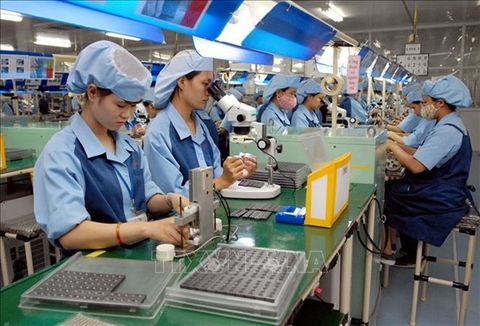Vietnam’s manufacturing output continues to rise
The Vietnamese manufacturing sector remained in growth territory at the start of the third quarter of the year, but there were some signs of demand softening, according to a survey released on August 8 by S&P Global.
 Illustrative image
Illustrative image
S&P Global said the Vietnam Manufacturing Purchasing Managers' Index (PMI) remained above the 50.0 no-change mark for the tenth successive month in July, signalling a further strengthening of business conditions. That said, at 51.2, down from 54.0 in June, the index signalled a softer improvement.
As such, output, new orders and employment all increased at weaker rates than in June. New orders increased for the 10th month running, but the rate of expansion eased to the weakest since April. New export business rose solidly, meanwhile, and at a faster pace than total new orders.
The continued growth of new orders encouraged manufacturers to keep expanding production in July. Output rose for the fourth successive month. That said, the rate of expansion was only marginal and the softest in the current sequence of growth amid signs of demand softening, shipping difficulties and price pressures.
There were signs, however, of price and supply pressures easing at the start of the third quarter.
On prices, according to the survey, the rate of input cost inflation slowed sharply and was the weakest since October 2020 as the prices of some inputs fell on global markets. That said, the latest rise was still above the series average amid reports of higher costs for oil, gas and freight. Similarly, output prices continued to rise, but the rate of inflation slowed and was only modest.
Suppliers' delivery times neared stabilisation as the rate of lead time lengthening softened for the second month running to the weakest in 22 months. Where delays continued, this was linked to issues with shipping and rising transportation costs.
Manufacturers continued to expand their workforce numbers in line with higher output requirements, the fourth month running in which this has been the case. The rate of job creation was solid despite slowing from the three-and-a-half year high posted in June. Meanwhile, backlogs of work were unchanged following a decrease in the previous month.
As well as taking on extra staff, firms also expanded their purchasing activity in July, due to rising new orders and efforts to build inventory reserves. Any attempts to accumulate stocks of purchases were in vain as preproduction inventories decreased at the sharpest pace in just over a year.
Stocks of finished goods also decreased, falling for the fifth month running and at a faster pace than in June. Some firms lowered inventories in response to slower new order growth, while others had found it easier to dispatch products for export.
Manufacturers remained optimistic that production will increase over the coming 12 months. Positive sentiment reflected hopes for further improvements in customer demand, stable market conditions, new product development and business investment. Close to 58% of respondents were optimistic about the outlook, while 11% were pessimistic./.
VNA

